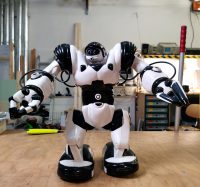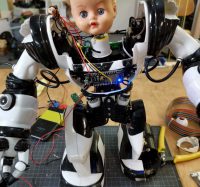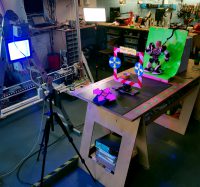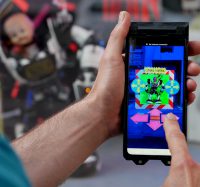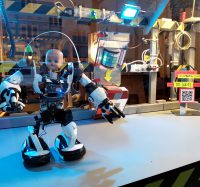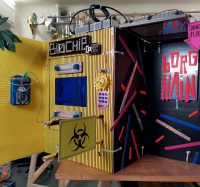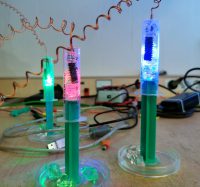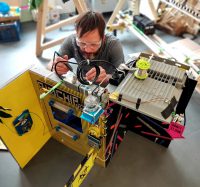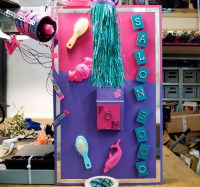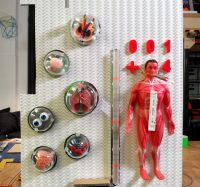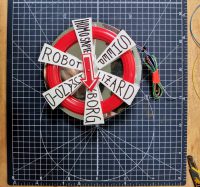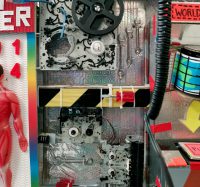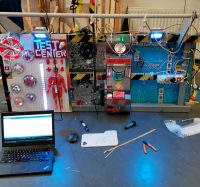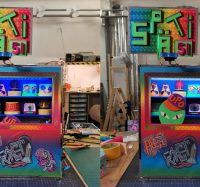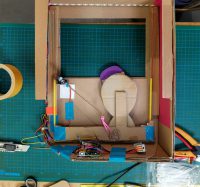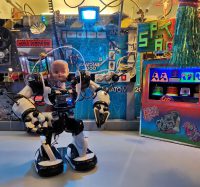Cyborg Control
Interactive installation with Niklas Roy
Berlin / 2021
Our workshop, which is a former shop space in eastern Berlin, has a large window facing the street. We’re used to people peeking in, but during the coronavirus pandemic the window has become an even more important way to maintain a dialogue with the neighborhood. Last spring Niklas displayed a hacked plotter for people to interact with. This spring the window was taken over by a remote-controllable cyborg. Over several weeks, we built a miniature world around the cyborg, so that there was always something new for the passers by to discover. People could control the cyborg with their smartphones and let him walk around, press buttons and trigger sensors.
The cyborgian world, which eventually filled the entire window, transferred ongoing pandemic themes into an imaginary microcosm. It was constructed largely using random materials that we had at home. If the cyborg was in need of a hair treatment, he could visit “Salon 3000”. At “Späti 51”, a Berlin-style convenience store, an alien would greet him. It was also possible to go dance in “Borghain” while the actual Berghain nightclub remained closed – after visiting a “Test Center” first. Even “World domination” button was available!
The cyborg was created out of a modified Robosapien, which we had received as a donation from our neighbour. We added some uncanniness to this well-built toy robot by replacing its head with a classically creepy doll head, including a glowing red LED in one eye. In order to hack Robosapien, existing tutorials proved helpful, such as instructions on how to control it via an Arduino. The hack boils down to simulating the infrared signal of the toy’s original remote control and we’re thankful for people posting the commands online (see e.g. Mark Craig’s website). As a controller we used NodeMCU V1.0 (ESP12-E Module), which is connected with the IR input of Robosapien’s main board.
See more documentation and technical details (and fails) on Niklas’ website!
We thank Senatsverwaltung für Kultur und Europa for their support, which made creating the installation possible. Thank you also to all people who stopped by our window and took a moment to escape into the cyborgian world.
Our workshop, which is a former shop space in eastern Berlin, has a large window facing the street. We’re used to people peeking in, but during the coronavirus pandemic the window has become an even more important way to maintain a dialogue with the neighborhood. Last spring Niklas displayed a hacked plotter for people to interact with. This spring the window was taken over by a remote-controllable cyborg. Over several weeks, we built a miniature world around the cyborg, so that there was always something new for the passers by to discover. People could control the cyborg with their smartphones and let him walk around, press buttons and trigger sensors.
The cyborgian world, which eventually filled the entire window, transferred ongoing pandemic themes into an imaginary microcosm. It was constructed largely using random materials that we had at home. If the cyborg was in need of a hair treatment, he could visit “Salon 3000”. At “Späti 51”, a Berlin-style convenience store, an alien would greet him. It was also possible to go dance in “Borghain” while the actual Berghain nightclub remained closed – after visiting a “Test Center” first. Even “World domination” button was available!
The cyborg was created out of a modified Robosapien, which we had received as a donation from our neighbour. We added some uncanniness to this well-built toy robot by replacing its head with a classically creepy doll head, including a glowing red LED in one eye. In order to hack Robosapien, existing tutorials proved helpful, such as instructions on how to control it via an Arduino. The hack boils down to simulating the infrared signal of the toy’s original remote control and we’re thankful for people posting the commands online (see e.g. Mark Craig’s website). As a controller we used NodeMCU V1.0 (ESP12-E Module), which is connected with the IR input of Robosapien’s main board.
See more documentation and technical details (and fails) on Niklas’ website!
We thank Senatsverwaltung für Kultur und Europa for their support, which made creating the installation possible. Thank you also to all people who stopped by our window and took a moment to escape into the cyborgian world.
